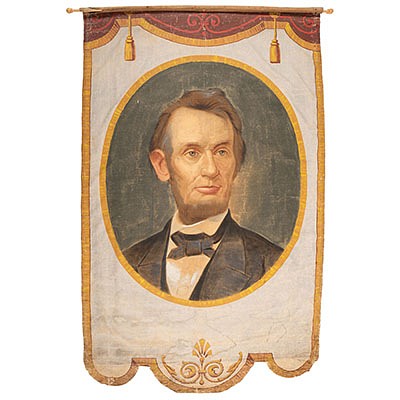[CIVIL WAR]. A group of 3 CDVs of identified US Navy officers, incl. John Walker, USS Baron DeKalb.
About Seller
6270 Este Ave.
Cincinnati , OH 45232
United States
With offices in Cincinnati, Cleveland and Denver, Cowan’s holds over 40 auctions each year, with annual sales exceeding $16M. We reach buyers around the globe, and take pride in our reputation for integrity, customer service and great results. A full-service house, Cowan’s Auctions specializes in Am...Read more
Two ways to bid:
- Leave a max absentee bid and the platform will bid on your behalf up to your maximum bid during the live auction.
- Bid live during the auction and your bids will be submitted real-time to the auctioneer.
Bid Increments
| Price | Bid Increment |
|---|---|
| $0 | $25 |
| $500 | $50 |
| $1,000 | $100 |
| $2,000 | $250 |
| $5,000 | $500 |
| $10,000 | $1,000 |
| $20,000 | $2,500 |
| $50,000 | $5,000 |
| $100,000 | $10,000 |
About Auction
Jun 25, 2021
The June 25 American Historical Ephemera and Photography Auction features an exciting assemblage of 18th-early 20th century material, including Civil War archives, Early Photography, Western Americana, Autographs and Manuscripts, and more. Cowan's Auctions dawnie@cowans.com
- Lot Description
CDV featuring a post-war oval bust view of a petty officer. Lima (Peru): Richardson, n.d. Signed in ink on verso "Compliments of / Yours Truly / Jno. Jay Gilroy / USN." (Average clarity, some soiling along edges and soft corners.) Nothing is known of Gilroy's service. Villroy L. Richardson (1927-1903) was a North American photographer and painter who emigrated to Lima in 1859 and would operate in Peru, Bolivia, and Chile through the end of the century.
[With:]
CDV period copy of Frank McIntyre. New York: J. Gurney & Son, 1863. Inked on verso "Frank Tatum McIntyre / Acting Ast. Paymaster / US Navy / Died October 13, 1863 / aged about 22." (Generational loss common to copy shots, rounded lower corners.) Frank T. McIntyre was appointed acting assistant paymaster 12/4/62, died on the DeSoto 10/13/63. The mail packet DeSoto had been taken up from the civilian trade and commissioned into the Navy in November 1861 as the USS De Soto. The De Soto spent most of the war alternating between the Eastern and Western Gulf Blockade Squadrons. She was a fast vessel and participated in the hunt for CSS Alabama during her foray in the Gulf. De Soto had a remarkably successful run between April and September 1863 overtaking and capturing no fewer than 15 Confederate blockade runners in the Gulf before her overworked engines required repairs at Key West in late October. By then Paymaster McIntyre had already died aboard, probably buried at sea.
[With:]
CDV of future admiral John G. Walker. Boston: J.W. Black, n.d. Pencil identified "Captain John Grimes Walker" in two different hands beneath portrait. (Strong clarity, near excellent.) John G. Walker: acting midshipman 10/5/50, midshipman 12/11/52, passed midshipman 6/20/56, lieutenant 1/23/58, lieut. commander 7/16/62, commander 7/25/66, captain 6/25/77, commodore 2/12/89, rear admiral 1/23/94, retired list 3/20/97. Walker compiled a commendable war record under David Dixon Porter on the Mississippi. During operations to capture New Orleans, Lieutenant Walker commanded the USS Baron DeKalb and led a division of gunboats in the attack on Forts Jackson and St. Philip afterwards earning promotion to lieutenant commander. He participated in early operations against Vicksburg including the attack of Haines Bluff and Arkansas Post as well as the Yazoo expedition, the engagement at Fort Pemberton and capture of Yazoo City. During the Vicksburg siege he commanded the naval land battery attached to the 15th Corps. Towards the end of the war Walker was active in operations that led to the capture of Fort Fisher and the subsequent bombardment of Fort Anderson and Casewell on the Cape Fear River, and finally in the capture of Wilmington, the last port of entry for Confederate blockade runners. Post-war, Walker was promoted to commander and held a varied array of important shore billets interspersed with shorter periods at sea. Significantly, Walker held the post of Chief of the Bureau of Navigation.
The Richard B. Cohen Civil War Collection Lots 79-98; 116; 138-153; and 266
Cowan's is pleased to offer the third installment of Richard B. Cohen's collection of Civil War Brown Water Navy photography. Richard was known to many in the field as a "disciplined collector who maintained a relatively narrow focus having built an important, perhaps unsurpassed collection in his area of specialization." From cartes de visite to large format photographs, this portion of the collection features a noteworthy selection of images of Brown Water Navy warships, among them, the USS Benton, Choctaw, Lafayette, and Louisville. Many important identified naval officers are also represented, including an exquisite CDV of the promising young officer, Lieutenant Commander William Gwin, who died of wounds aboard the USS Benton following an artillery duel with Confederate forces at Snyder's Bluff, and an exceptionally large war-date photograph of the controversial commander of the USS Pittsburgh, Egbert Thompson.
This auction also features a premiere selection of autographs and manuscripts from Richard's carefully curated collection. Highlights include a letter from Jefferson Davis to his distant cousin, John J. Pettus, Governor of Mississippi, dated a year before secession, conveying intricate plans for securing armaments in preparation for the war; an Abraham Lincoln signed endorsement; a letter from Admiral D.G. Farragut from New Orleans, offering excellent insight into his "political" thinking as well as his dedication to his work; correspondence from Gideon Welles, David Dixon Porter, U.S. Grant, and W.T. Sherman; and a pair of superb letters with highly descriptive accounts of the Battle of the Monitor and Merrimac.
Provenance: The Richard B. Cohen Civil War Collection - Shipping Info
-
SHIPPING & PICKUPS Cowan’s Cincinnati Office offers an in-house, full-service shipping department which is unparalleled in the auction industry. Shipping costs are provided with your finalized invoice 24-48 hours after auction. For furniture and oversized items, we recommend using third-party services. For more information, contact cowansshipping@hindmanauctions.com. NOTE: All pickups and preview are by appointment only. To make an appointment, please call 513-871-1670 or email cincinnati@hindmanauctions.com Buyers are required to pay for all packing, shipping and insurance charges. Overseas duty charges are the responsibility of the successful Bidder. Be aware that for larger and/or valuable items, shipping charges can be substantial. - Shipping charges include insurance for your order while in transit. If you have private insurance we will adjust your charge to include only packing and shipping. - Please allow 14 – 21 days after payment to package and ship your purchase as carefully as possible.
-
- Buyer's Premium



 EUR
EUR CAD
CAD AUD
AUD GBP
GBP MXN
MXN HKD
HKD CNY
CNY MYR
MYR SEK
SEK SGD
SGD CHF
CHF THB
THB![[CIVIL WAR]. A group of 3 CDVs of identified US Navy officers, incl. John Walker, USS Baron DeKalb.](https://s1.img.bidsquare.com/item/l/8589/8589562.jpeg?t=1LMY24)
![[CIVIL WAR]. A group of 3 CDVs of identified US Navy officers, incl. John Walker, USS Baron DeKalb.](https://s1.img.bidsquare.com/item/s/8589/8589562.jpeg?t=1LMY24)











